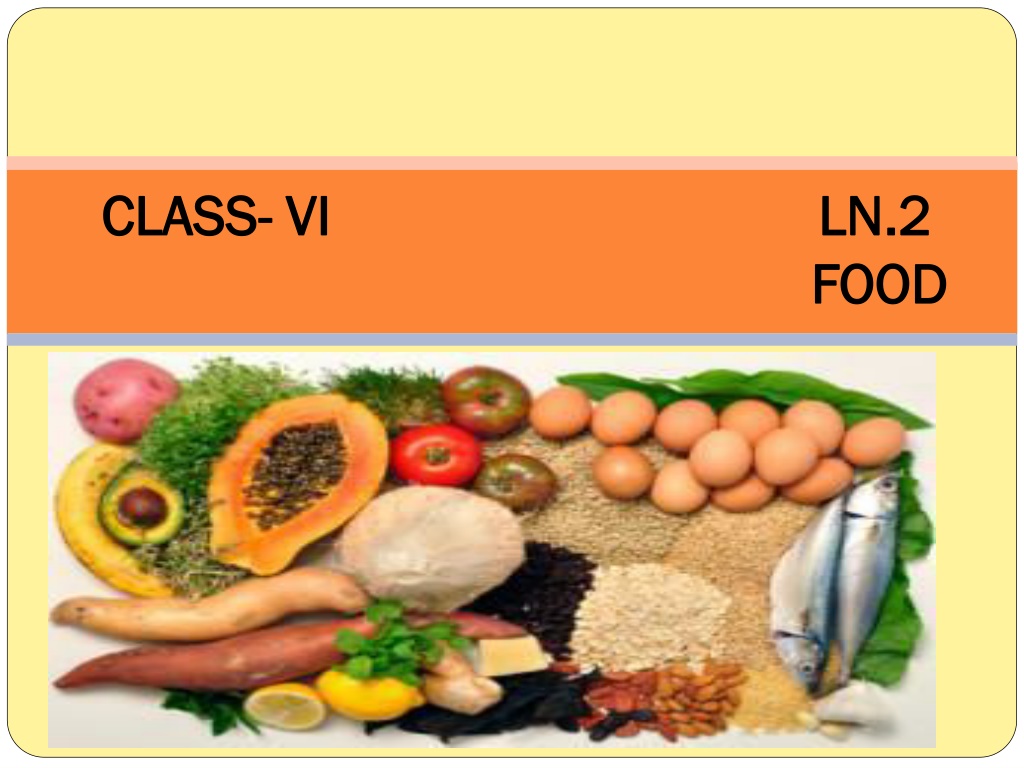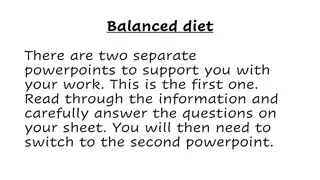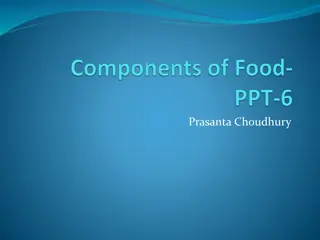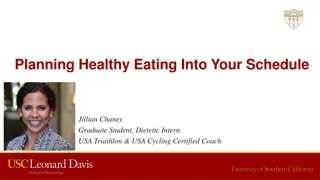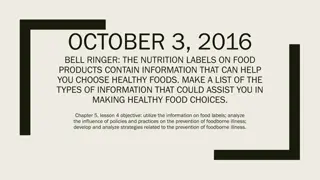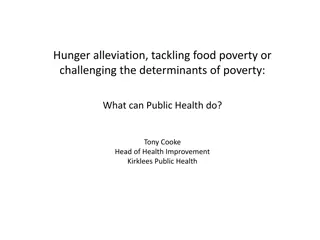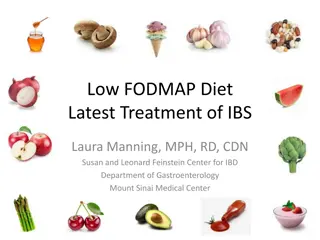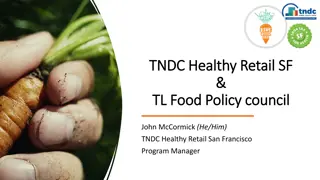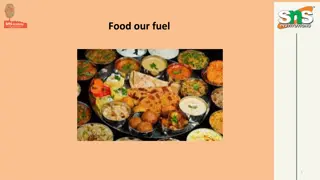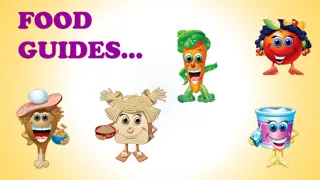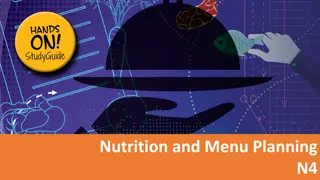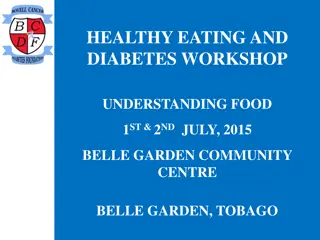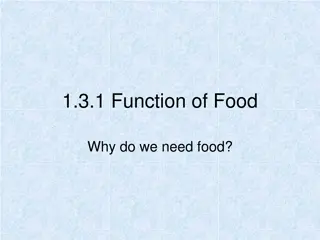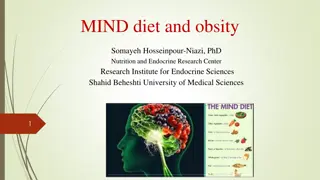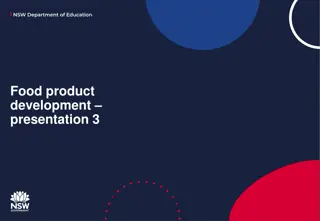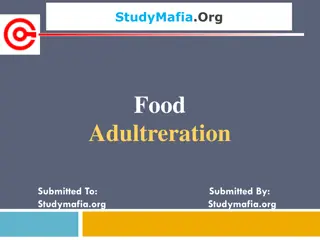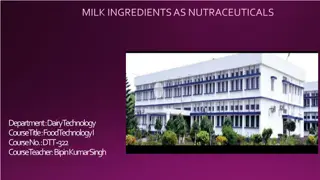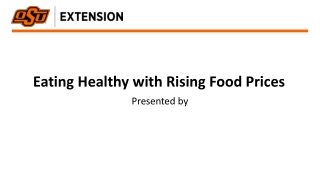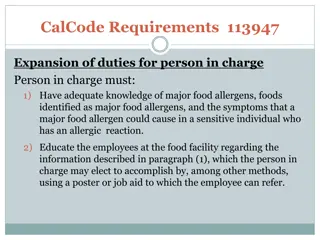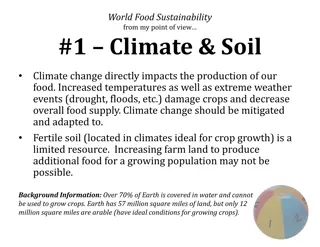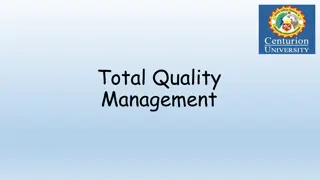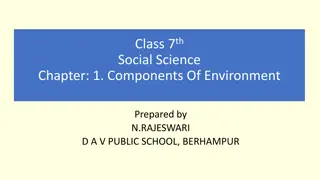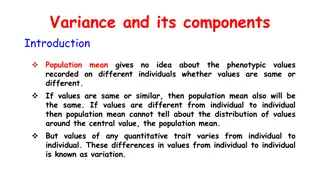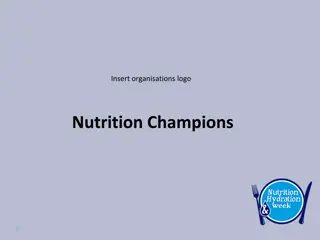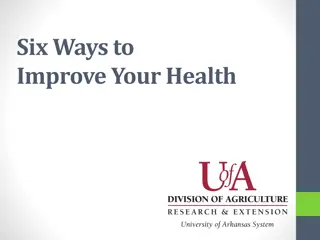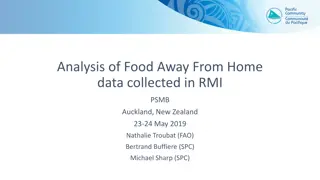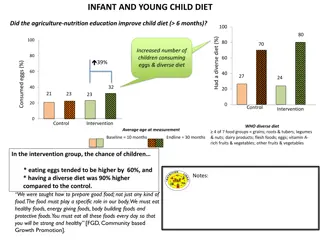Understanding the Essential Components of Food for a Healthy Diet
Explore the key sources of food from plants and animals, and discover the crucial components of food - carbohydrates, proteins, fats, and vitamins. Learn how these nutrients play vital roles in providing energy, building blocks for the body, and overall health maintenance.
Download Presentation

Please find below an Image/Link to download the presentation.
The content on the website is provided AS IS for your information and personal use only. It may not be sold, licensed, or shared on other websites without obtaining consent from the author. Download presentation by click this link. If you encounter any issues during the download, it is possible that the publisher has removed the file from their server.
E N D
Presentation Transcript
CLASS CLASS- - VI VI FOOD LN.2 LN.2 FOOD
SOURCES OF FOOD SOURCES OF FOOD 1. Food From Plants. Cereals that we get from plants are impotant sources of energy , which are the major components of food. Pulses are the important sources of proteins in our diet. Green leafy vegetables, fruits are also obtained from plants which are good sources of proteins. Oils are the sources of fats and spices add flavours and taste to our food.
2. Food From Animals Milk giving animals are called Milch animals. Eg.Cows , buffalloes , Camels Animals are also important source of food. Eggs , Meat , Fish are important sources of proteins.
COMPONENTS OF FOOD COMPONENTS OF FOOD Every organism needs food to provide essential nutrients. Nutrients: The nutrients are the chemical substances needed by our body for proper growth and functioning. Main Nutrients are: Energy Giving Food : Carbohydrates and Fats Body Building food : Proteins Protective Food : Vitamins And Minerals For Reference watch out: https://youtu.be/f_LvyD-q4eo?t=32
1. Carbohydrates: 1. Carbohydrates: These are chemical substances(compounds) containing carbon, hydrogen and oxygen and are the main source of food. Provides energy to our body for carrying out our daily activities. Common carbohydrate present in our foods are in the form of sugar and starch.
2. PROTEINS : 2. PROTEINS : These are the chemical substances containing nitrogen, carbon, oxygen and hydrogen. Essential for growth repair and maintainence of our body. We get proteins from both plants and animals both. Proteins are known to form haemoglobin which carries oxygen from one part of the body to another. It also helps in creating antibodies in the body which fight infecton and protect the body from disease.
3. FATS 3. FATS Fats are energy giving components and make the body strong. We get fats from animals as well as plants. Fats provide more energy than carbohydrates. These protect internal organs against shock and also contain many important hormones to regulate our body activities.
4. VITAMINS : 4. VITAMINS : Vitamins are a group of nutrients that our body requires in small quantities. They are essential for proper working of the body. They are of two types : Water soluble vitamins : Vitamin- B, C Fat soluble vitamins : Vitamin-A,D, E , K
VITAMIN DEFICIENCY DISEASES VITAMIN DEFICIENCY DISEASES Vitamin-C It is water soluble vitamin. It affects bones, joints,teeth and gums. Deficiency causes disease called scurvy. A person become weak and anaemic. Develops spongy and bleeding gums.
Vitamin-D It is fat soluble. Its inadequate intake affects the bones of our body. It causes diseases like rickets , pigeon-chest. Deficiency of Vitamin D also causes calcium and phosphorus deficiency as Vitamin D stimulates the absorption of minerals like calcium and phosphorus. It is common among the economically poor section of the society.
5. MINERALS : 5. MINERALS : Minerals are the nutrients that contain certain elements like calcium, iron ,etc. They perform particular fuctions in the body. Their deficiency in our diet leads to deficiency diseases.
Iodine Deficiency : For Reference Watch Out: https://youtu.be/0bg7pxtYn20?t=6
BALANCED DIET : BALANCED DIET : Definition: A diet that contains the proper proportion of carbohydrates, proteins, fats, vimatins, minerals and water necessary to maintain good health. It is important for proper growth and important of body. It can be vegetarian or non-vegetarian. A balanced simple meal is more nourishing than an imbalanced or junk. For more reference check out: https://youtu.be/sj-jvcVc8WA?t=36
FACTORS RESPONSIBLE FOR POOR FACTORS RESPONSIBLE FOR POOR HEALTH : HEALTH : 1. Malnutrition It is the condition when body doesn t get the optimum nutrition required for the body i.e. Deficiency of Proteins, Carbohydrates and fats. It is of 2types : 1. PEM: Protein Energy Malnutrition 2. PCM: Protein calorie malnutrition Such condition can lead to problems in children like Kwashiorkar and Marasmus.
EXTRA QUESTIONS 1. What are milk giving animals called ? Ans. Milk giving animals are known as Milch animals. 2. Define Nutrients. Ans. The important components of food i.e; Carbohydrate, Proteins ,Fats, Vitamins and Minerals are called Nutrients. 3. Name the energy giving food. Ans. Carbohydrate and fats are known as energy giving food. 4. Name the body building food. Ans. Proteins are known as the body building food. 5. Name the protective food. Ans. Vitamins and Minerals are known as protective food. 6. Define carbohydrate. Ans. Carbohydrates are made up of carbon, hydrogen and oxygen which are present in our food in the form of sugar and starch. 7. Name some carbohydrate rich food. Ans. Fruits like banana,mango,litchi,melon etc. are rich in sugar. Cereals like wheat,rice and maize are rich in starch. Vegetables like potato and sweet potato are rich in starch.
8. Define Proteins. Ans. Proteins are made up of carbon , hydrogen, oxygen, nitrogen and small quantity of sulphur and phosphorus. 9. Write the function of proteins in our body. Ans. Proteins help in building up the developing tissues of a growing child. It also take care of the wear and tear of the body tissues at all ages. 10. Name the richest source of protein. Explain it in brief. Ans. Soyabean is one of the richest source of protein. As it contains twice as much proteins as meat and four times as much as Eggs. 11. Explain the importance of vitamin in our body. Ans. Vitamins are essential for maintaining good health and proper growth of the body. It plays an important role in most biochemical changes within our body. 12. Name the main source of vitamins. Ans. Plants are the main source of vitamins. 13. Name the water soluble vitamins. Ans. Vitamin-B and Vitamin C are water soluble . 14. Name the fat soluble vitamins. Ans. Vitamin-A,D E and K are the fat soluble vitamins.
15. Name the disease caused by the following vitamins with symptoms. Ans. Vit.A : Nightblindness ,Dullness of skin. Vit.B : Beri-Beri, Weak muscles and weakness. Vit.C : Scurvy spongy and bleeding gums. Vit.D : Rickets , curved and deformed bones, bow legs. Vit.E : Sterility Vit.K : Prolonged and profused bleeding due to delayed clotting of blood. 16. Name the important minerals required by our body. Ans. The important minerals needed by our body are sodium , potassium, magnesium, calcium, phosphorus, iron, iodine. 17. Explain the sorces and functions of the following minerals. Ans. Calcium : It is obtained from milk and its products, green leafy vegetables. It is necessary to build healthy bones and teeth. Phosphorus : Sources are milk,cereals,pulses,fish and meat. It helps in the growth of bones and teeth. Iron : Sources are green leafy vegetables other vegetables,nuts and jiggery. It helps in the formation of haemoglobin in the blood. Its deficiency causes anaemia. Iodine : It is obtained from fruits vegetables ,sea food, iodised salt. It helps in proper functioning of thyroid gland. Its deficiency causes goitre. 18. What do you understand by roughage? Ans. Green vegetables, fruits and whole grains contains large amount of cellulose that cannot be digested by our body. Cellulosic dietrary fibres are called roughage.
19. Write the function of roughage. Ans. Roughage helps in bowel movement and prevents constipation. 20. Define a Balanced diet. Ans. A balanced diet consist of all the nutrients which are important for the proper growth and development of the body. 21. Write the full form of PEM and PCM. Ans. PEM : Protein Energy Malnutrition PCM : Protein Calorie Maltrution 22. Name the two diseases caused by malnutrition. Ans. Kwashiorkor and Marasmus. 23. Write the symptoms of kwashiorkor and at which age this disease is seen. Ans. The growth of the child is retarted . The face, feet and abdominal region get swoolen due to water retention. Discolouration of hair and diarrhea are common in such children. 24. Write the symptoms of marasmus. Ans. The deficiency causes : Waisting of muscles. The child becomes very thin. It results in general weakness and retarted growth.
PRESENTED BY: DEVJANI SARKAR DEVJANI SARKAR
